-
Posts
316 -
Joined
-
Last visited
-
Days Won
40
Content Type
Profiles
Forums
Gallery
Events
Articles
Blogs
Downloads
Community Map
Posts posted by V7#5b9
-
-
@NeilES335 I’m sure Greg will have some words of wisdom on that, but you may find the following videos helpful as well:
-
 1
1
-
-
@NeilES335 You’re welcome. I’m not a huge fan of Martino myself, but I try to listen to various jazz guitar artists as part of a learning experience. Pat has a unique perspective on the instrument, which he reveals in “The Nature of Guitar” he did for TrueFire.
-
In my vast array of music theory books Tom Kolb’s “MUSIC THEORY Everything You Ever Wanted to Know But Were Afraid to Ask” has its place. Tom’s main approach is based on brief conceptual descriptions and formulas. It covers a lot of information, but you may find it kind of dry. I use it mainly as an additional reference.
If you want to get a relatively quick grasp of basic music theory and understand the big picture, I would recommend “The Everything Music Theory Book” by Marc Schonbrun. Marc’s easy and engaging language makes reading the book and learning theory enjoyable. It actually has a companion book by the same author: “The Everything Reading Music Book.” There is some overlap between the books, but they complement each other perfectly. Then, you will be able to tackle more advanced music theory books.
Steve usually recommends: “Edly’s Music Theory for Practical People.” It’s very good as well.
I hope this helps.
-
 1
1
-
-
@Wim VD You’re welcome. I feel humbled by your favourable comment. I’ve never had the gift of being able to play by ear and now my condition isn’t ideal, either. I have to wear hearing aids and deal with tinnitus. Fortunately, these days the abundance of resources makes it possible to learn music theory thoroughly and compensate for the ear’s shortcomings to a substantial degree. My resource library is relatively big. I’m grateful to those who developed and codified the language of music.
-
 1
1
-
-
18 hours ago, Wim VD said:
I am currently making my first small steps in soloing, so this topic is very relevant to me. I have been trying out playing scales and playing chord tones over chord progressions, and the chord tone approach sounds beter to my ear. So I decided to focus on learning chord arpeggios in the months to come, starting with the dominant 7th chords, and then the major and minor 7th and eventually the m7b5.
Any advice is welcome on this topic. When it comes to soloing, I feel like an absolute beginner again :-)
@Wim VD The reason the chord tone approach sounds better to you is because you are using the harmonic framework of the progression. Chord tones are the safe, sweet notes the chords or arpeggios are made of. They are the notes you can hold or land on. When it comes to the seventh chords, the third and the seventh are the guide tones and you should target one of them when making the chord changes. Of course, the chord tones alone don’t make a great solo, but if you start with them, you will get the harmony into your ear and you will hear the chord changes. Then, you can start adding approach notes and here the devil is in the details that are way beyond the scope of a simple post.
So you decided to focus on learning the arpeggios starting with the dominant 7th chords. That’s a good idea because all you need for a traditional 12 bar blues is this one type of chord. The harmonic simplicity and structural economy of the 12 bar blues makes it the perfect vehicle for tackling soloing and improvisation in the early stages. So again, you start with chord tones only, then you add approach notes thereby building your solo from the bottom up. You can learn the arpeggios in isolation or from the perspective of its parent scale. The mixolydian which can be thought of as a major scale with a lowered seventh is the parent scale for a dominant 7th chord.
After you’ve completed Session 19, you may want to reach for a resource that thoroughly deals with soloing and improvisation in your chosen genre.
-
 1
1
-
 1
1
-
-
Thanks Neil! I listen to Virtuoso every now and then, too.
-
Although the following article discusses the concepts in the context of jazz, they do apply to other genres as well.
Chord-Tone vs. Chord-Scale Soloing
by Professor Hal Crook"For the past few decades or so, more and more jazz players have been using the chord-scale approach for soloing over chords in progressions. The chord-scale approach is based on the idea that if a chord is diatonic to a scale, then that scale can be used as a source to derive melody on that chord."
You will find the full article at BERKLEE TODAY.
PS Also see the sidebar at the end of the article
-
An Easy System To Memorize Every Major Scale
For each major scale, memorize the altered notes (sharps or flats) only if they constitute the minority, otherwise memorize the naturals. For example, in the case of B major you would memorize that B and E are natural and that the rest are sharp. Next, simply recite the musical alphabet starting with B and make every note “sharp” except for B and E:
B – C# -D# – E – F# – G# – A#
Memorizing just B and E for the above, is much easier than having to memorize C#, D#, F# , G# and A#!Here is a list of the 12 major scales as they appear on the descending (counterclockwise) CIRCLE OF FIFTHS starting with C MAJOR and what to memorize:
C MAJOR: All natural — C D E F G A B
Major Scales With Flats:
F MAJOR: memorize Bb, the rest are natural — F G A Bb C D E
Bb MAJOR: memorize Bb and Eb, the rest are natural — Bb C D Eb F G A
Eb MAJOR: memorize Eb, Ab and Bb, the rest are natural — Eb F G Ab Bb C D
Ab MAJOR: memorize C, F and G, the rest are flat — Ab Bb C Db Eb F G
Db MAJOR: memorize F and C, the rest are flat — Db Eb F Gb Ab Bb C
Gb MAJOR: memorize F, the rest are flat — Gb Ab Bb Cb Db Eb FMajor Scales With Sharps:
B MAJOR: memorize B and E, the rest are sharp — B C# D# E F# G# A#
E MAJOR: memorize E, A and B, the rest are sharp — E F# G# A B C# D#
A MAJOR: memorize C#, F#, and G#, the rest are natural — A B C# D E F# G#
D MAJOR: memorize F# and C#, the rest are natural — D E F# G A B C#
G MAJOR: memorize F#, the rest are natural — G A B C D E F#For the enharmonic scales (C# or Db, F# or Gb and B or Cb) at the bottom of the Circle of Fifths, memorize:
C# MAJOR: all are sharp — C# D# E# F# G# A# B#
F# MAJOR: memorize B, the rest are sharp — F# G# A# B C# D# E#
Cb MAJOR: all are flat - Cb Db Eb Fb Gb Ab Bb-
 2
2
-
 2
2
-
-
“An Evening With Pat Martino” is a treat for any guitar student who is interested in tackling jazz guitar. I hope you will find it inspirational, educational and motivational. The preceding player’s profile comes from the “20th Century JAZZ GUITAR” free e-book by Richie Zellon, and serves as a brief historical background regarding the artist.
“Pat Martino
BEBOP, HARD BOP, POST-BOPBorn Pat Azzara in South Philadelphia, Martino began playing professionally in 1961 at age 15. Throughout his early career he worked as a sideman with saxophonists Willis Jackson and Eric Kloss, as well as various organists including Jack McDuff, Jimmy Smith, Don Patterson and Richard “Grooves” Holmes. Martino made his recording debut as leader in 1967 with the album “El Hombre” on Prestige Records.
In 1980 Martino suffered a nearly fatal brain aneurysm which resulted in the loss of his memory and playing abilities. With the help and encouragement of family and friends in conjunction with his old recordings, he was able to regain his cognitive abilities and eventually made a full recovery. He resumed his recording career in 1987 with the recording “The Return” and has kept a busy performing schedule ever since.”
-
“An Evening With Joe Pass” is a treat for any guitar student who is interested in tackling jazz guitar. I hope you will find it inspirational, educational and motivational. The preceding player’s profile comes from the “20th Century JAZZ GUITAR” free e-book by Richie Zellon, and serves as a brief historical background regarding the artist.
“Joe Pass
BEBOP, HARD BOPJoe Pass (Joseph Anthony Passalaqua) was born on January 13, 1929 in New Brunswick, New Jersey and raised in Johnstown, Pennsylvania. His father, an Italian steel-worker bought him his first guitar at age 9 and encouraged him to learn songs and improvise by ear after witnessing the youngster’s early musical tendencies. By the time he was 14, Pass was already working with local bands and later went on the road at 18 with the Tony Pastor band. After serving in the military he spent a period in New York during which he started using drugs and eventually ended up spending time in several rehabilitation centers as well as jail.
As a result of his drug addiction, Pass spent most of the 50’s in obscurity. After over 10 years trying to kick drugs, Pass entered the Synanon Center in California where he made his famous Sounds of Synanon (1961) recording with other residents who were also jazz musicians.
Upon leaving Synanon, Pass gradually became one of the most in demand guitarists in the Los Angeles studio scene where he worked for 10 years. During this period he worked as a sideman with Louis Bellson, Frank Sinatra, Sarah Vaughan, Joe Williams, Della Reese, Johnny Mathis, as well as on numerous TV shows including The Tonight Show starring Johnny Carson, The Merv Griffin Show, The Steve Allen Show, and others.
After recording several albums for the Pacific Jazz and World Pacific labels throughout the 60’s, Pass was signed by Norman Granz, the producer of Jazz at the Philharmonic and founder of Verve Records to his new Pablo Records label in 1970. In 1974, Pass released his now classic solo album Virtuoso. This initial recording along with the entire series that followed, has redefined the art of solo jazz guitar. As a result of these solo recordings and concerts, Pass finally achieved the notoriety he deserved and was consistently listed in the jazz polls year after year. During this same period at Pablo, he recorded a set of widely acclaimed guitar/vocal duet records with Ella Fitzgerald. Joe Pass died from liver cancer in Los Angeles, California, at the age of 65.”
-
 2
2
-
-
It’s a sheer beauty, Ben.
 It almost makes me “GAS.” Luckily, I’ve built enough immunity to resist the urge.
It almost makes me “GAS.” Luckily, I’ve built enough immunity to resist the urge.
-
On 2018-01-14 at 11:37 AM, Triple-o said:
How many of you have the B7b9 (7 position) listed as one of the many impossible chords? Just curious, how does someone with large hands get around this chord used in “Autumn Leaves”. I am thinking that maybe B7 is the solution since it follows F#m7b5.
@Triple-o When a particular chord form is impossible to finger, you have several options:
- Try an alternate fingering.
- Use an easier to finger inversion of the chord.
- Simplify the chord by omitting the root, 5th, an extension, or alteration.
- Use the basic 7th chord.
- Find a substitute chord.
I’ve made a small example with Neck Diagrams application for better illustration.
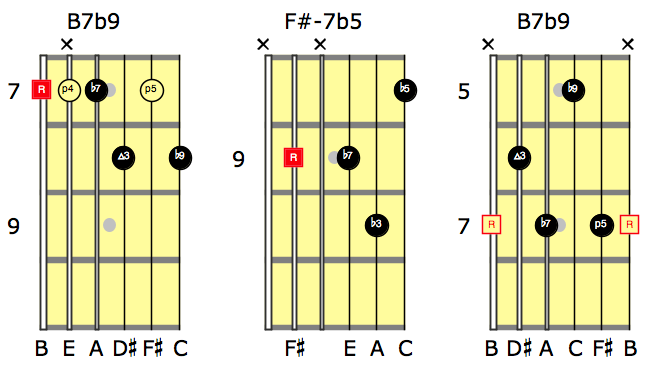
Looking at it from left to right, I assume the 1st form is the one you’re having trouble with. Some suggestions have been made by @Wim VD and @tjmeyers already.
Let me add that the most important chord tones that define the chord quality are the guide tones, namely: the 3rd and 7th (in the case of a dominant chord those are the major third and minor seventh). Even this basic ‘shell’ chord can be used in the context of a progression, especially when you are accompanied by a band or jam track with bass and possibly keyboard.
The second form (F#-7b5) and the third form (B7b9) played in the mid to upper register are the ones Steve had scribbled on the Autumn Leaves PDF he uploaded to the old forum some time ago. As you can see Steve’s B7b9 is a rootless one, but I’ve included the roots (not to be played) for reference.
As an additional thought let me point out that jazzers think of chords in terms of four part structures that are placed on different string sets. A seventh chord with its four notes is the basis for transformation into an extended or altered chord. Then you can enhance it by doubling one of the notes, adding another one, taking one away, etc.
I hope it helps.
-
 1
1
-
@rkl312 You may want to try Music Reading for Guitar THE COMPLETE METHOD by David Oakes. It’s currently not available on the US amazon site, so I’m giving you the Canadian link.
-
 2
2
-
-
My current guitar set comes from various manufacturers: D’Angelico EX-DC (semi-hollow electric), Carvin DC145 (custom shop solid-body electric), Ibanez AKJ95 (hollow body electric) and a replica of Epiphone Paul McCartney 1964 Texan (acoustic). Each guitar is different so it’s hard to compare makers by guitar type criterion. I like them all. They are well made, provide excellent playability and sound great. I hesitate to pick one manufacturer over the other, but if I was pressed hard to grade them by their sound workmanship, I would place them in the following order: #1 Carvin, #2 D’Angelico & Epiphone, #3 Ibanez.
-
For those interested in adding more chords and learning how to build them on the fretboard, there is a website where you can download and compile PDF files of Ted Greene’s revolutionary V-System for free. Steve has mentioned Ted’s Chord Chemistry book a few times. I don’t have the book, but as I recall Steve had said it was mostly page after page of chord diagrams. This on the other hand is a system that can be used to construct chords on the fretboard. Here’s the link to Ted Greene’s V-System.
I hope you will find the methods helpful.
-
 2
2
-
 2
2
-
-
-
We don’t have the “Helpful Guitar Resources” Forum yet, so I’m putting it here for the time being. I have a couple of publications from FUNDAMENTALCHANGES and I find them to be very well thought out and structured. The site has a pretty big selection by now, and everyone can find something for themselves.
-
 2
2
-
-
Pain is a very real issue. Warm-up exercises and stretches are extremely important. I myself had to deal with tendonitis and trigger finger for over six months. Had to go for physiotherapy, but it only helped partially. I had to continue prescribed exercises at home and that’s probably the case for most people. Got rid of the trigger finger eventually, but I still get somewhat stiff fingers in the morning. I no longer pick up the guitar without proper warm-up and stretches as I sometimes used to. I remember Six String posted similar, if not the same, videos on the old forum.
Gary Crowley identifies himself as a chronic joint pain specialist, seems very credible and shares a lot of information in both video and written formats on his website. Of course, one should consult a physician first, but in my case the advice given by my physiotherapist matched that of Gary’s. As always though, prevention is the best medicine.
-
I fully concur with your policy, Steve. Actually, I have a little suggestion I’ll put in the Discussion Board Beta Observation/Suggestions thread.
-
 3
3
-
-
As Diane says E-G-B-D is Em7 and E-G-B-D# is Emin-maj7. In a minor tonality Emin-maj7 is the I chord of the harmonic minor which is a variation of a minor scale, formed by raising the seventh note one half step. Doing so creates a leading tone to the scale. In the natural E minor, unlike the E major tonality, the dominant is built over the seventh degree of the scale which is bVII7 or D7.
I hope this clarifies the confusion somewhat.
-

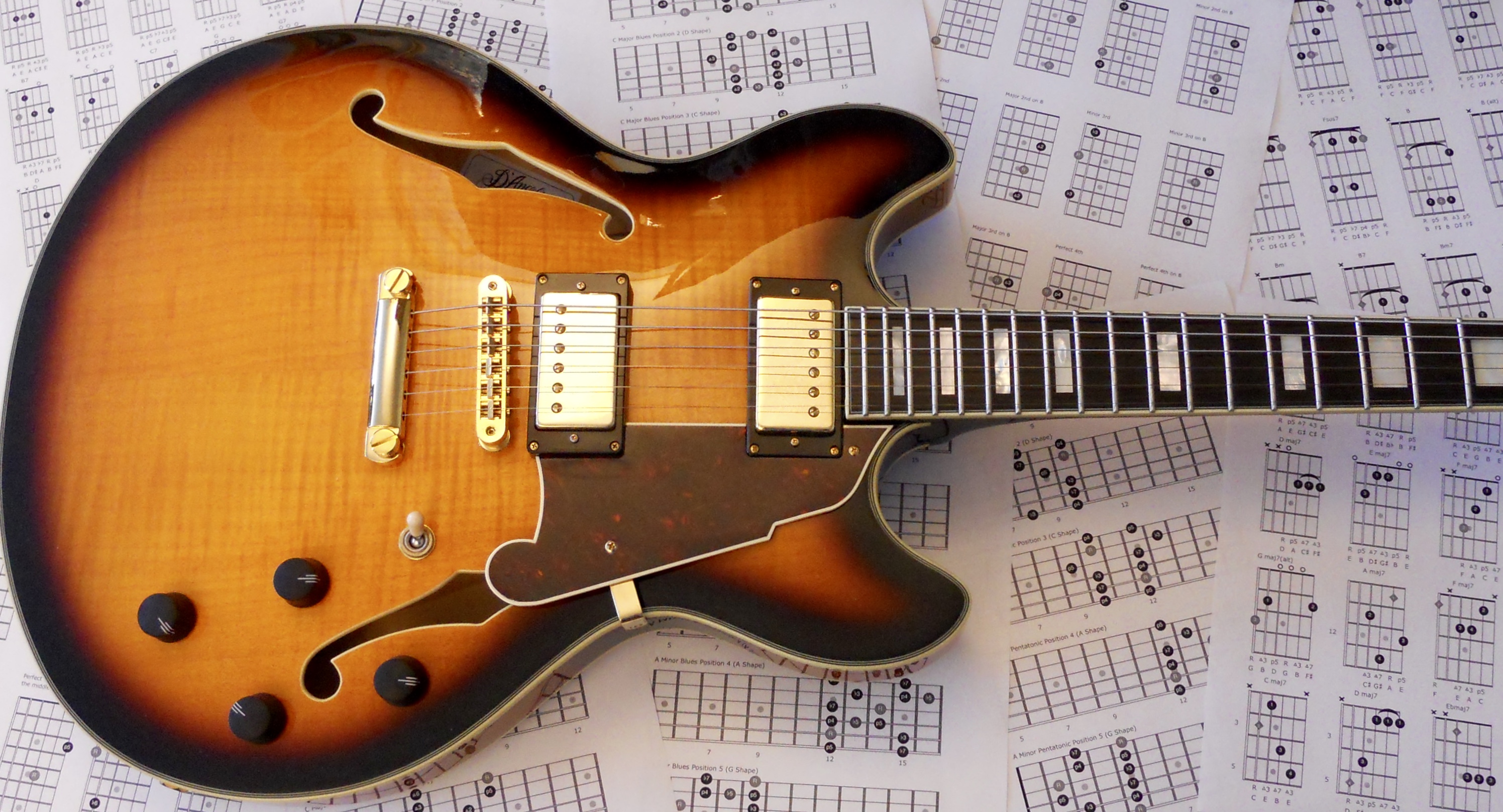
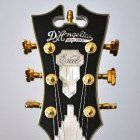
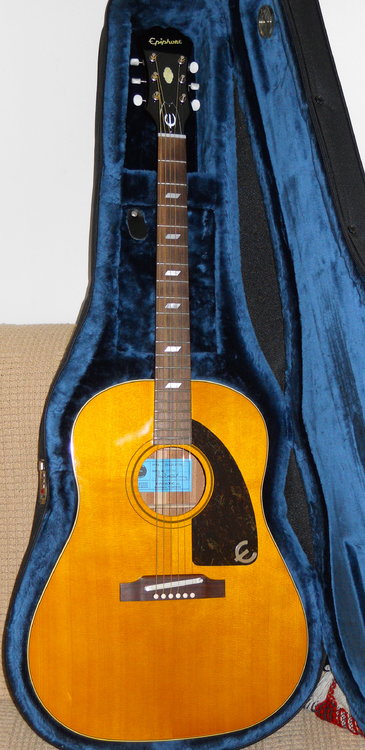
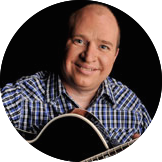
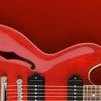
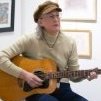
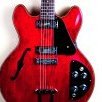
Entry Level Nylon String Guitar
in Guitar Gear, Amps, Effects, Pedals
Posted · Edited by V7#5b9
@NeilES335 Do you remember this one?
I think I posted it on the old forum at some point. It’s currently one of Taylor’s legacy models, but Long & McQuade may have two in stock in Ontario. I wouldn’t mind having one myself. It’s right around your price point.